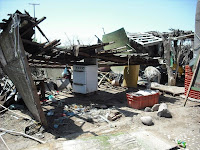Among the recent news on climate change is today's introduction of the Senate version of a climate bill (from MSNBC.com). We're happy to see a larger cut in the short-term (20% by 2020) and other improvements from the House version, but this bill is a starting point that is sure to be negotiated downward as it makes it way through the Senate. Also coming out today is our new page on how sea turtles will be affected by a changing climate, you might be surprised at how many ways these creatures will be affected. An obvious impact on turtles is sea level rise, here's a TreeHugger article on the imminence of a two meter rise (6.5 feet for the metric-impaired).
Despite the uncertain fate of climate legislation in the Senate, there is some good news out there. Japan's new government has announced a much stronger commitment to reducing emissions (from BBC) and China is rapidly moving forward on renewable energy (from Grist). Companies are jumping ship from the US Chamber of Commerce (also Grist) for their stance on the issue (our neighbor in Beaverton, Nike just joined the list!). I used to work for a group called Ozone Action that effectively dismantled a corporate group called the Global Climate Coalition, its good to see this kind of work still going on. However, even when there's good news, like when WWF discovers more than 150 new species in the Greater Mekong region of Asia, there's a flip side - these species may already be threatened by climate change.
We encourage everyone out there who cares about wildlife to get involved in the upcoming debate about climate legislation. One great way to take part will be to join 350.org's international day of action, with events around the world. Expect to see from us several ways you can help through our Twitter, Facebook, blog and other social networks.
-Brad Nahill




